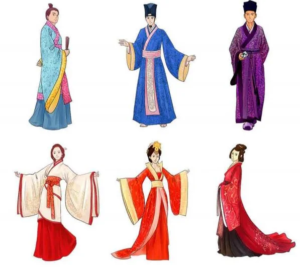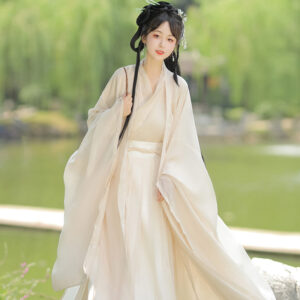

The grooming standards associated with Hanfu encompassed a range of elements including clothing styles, hairstyles, accessories, and makeup, all of which reflected social status, cultural values, and aesthetic preferences in ancient Chinese society. Here’s a detailed overview:
1. Clothing Styles
- Flowing Silhouettes: Hanfu is characterized by its flowing lines and graceful forms. The style often included layered garments that conveyed elegance and modesty.
- Symbolic Colors: Different colors held specific meanings. For example, red symbolized good fortune, while white was associated with mourning. The choice of color often reflected the occasion and the wearer’s social status.
- Material Choices: The fabric used in Hanfu varied according to social rank. Nobility often wore silk with intricate embroidery, while commoners typically used simpler materials like cotton or linen.
2. Hairstyles
- Cultural Significance: Hairstyles were not just fashion statements; they held deep cultural meanings. Hair was considered a vital gift from one’s parents and was treated with great respect.
- Men’s Hairstyles: Common styles included the jian, where the front hair was kept short while the back was long, often tied into a bun (shu) after coming of age.
- Women’s Hairstyles: Women sported various styles depending on their age and marital status. Young, unmarried women typically wore their hair down or in simple braids, while married women favored more elaborate buns adorned with accessories.
3. Accessories
- Hairpins and Ornaments: Accessories like hairpins, jade ornaments, and silk ribbons were essential for women. They not only secured hairstyles but also signified social status and personal taste.
- Belt Buckles and Tassels: Men often wore jade belt buckles and tassels as symbols of rank and refinement. These accessories added to the overall aesthetic of Hanfu attire.
4. Makeup and Facial Adornments
- Cultural Practices: Makeup in ancient China transcended mere cosmetic purposes; it embodied deeper cultural meanings. Women often used white powder (doufen) for a pale complexion and rouge for vibrant cheeks.
- Evolution Over Time: Makeup styles evolved through dynasties. While early periods favored natural looks, later periods embraced more elaborate cosmetics that enhanced beauty according to prevailing aesthetic ideals.
5. Etiquette and Conduct
- Confucian Values: The grooming standards associated with Hanfu were closely tied to Confucian ideals of respect, humility, and propriety. The way one dressed and groomed themselves reflected their moral character.
- Behavioral Norms: Specific etiquette governed how individuals interacted while wearing Hanfu, including gestures, bows, and handling of accessories. Proper grooming demonstrated respect for tradition and contributed to societal harmony.
Conclusion
The grooming standards associated with Hanfu were multifaceted, encompassing clothing choices, hairstyles, accessories, makeup, and behavioral norms. Each element played a crucial role in expressing social identity and cultural values in ancient China. These standards not only dictated fashion but also provided insight into the societal norms and beliefs that shaped Chinese civilization throughout history.
Share this post
Recent Posts


What were the key features of Hanfu during the Tang Dynasty?

How did Hanfu styles vary during different Chinese dynasties?

What accessories are typically worn with Hanfu?

How do you choose the right Hanfu for different seasons?

Newsletter
Popular Categories
Related Post
Sed aliquam, tortor et sodales malesuada, lorem leo luctus tellus, quis interdum eros nibh in nunc. Cras dignissim malesuada, lorem leo luctus

What are the winter hanfu called?

What were the key features of Hanfu during the Tang Dynasty?

How did Hanfu styles vary during different Chinese dynasties?


